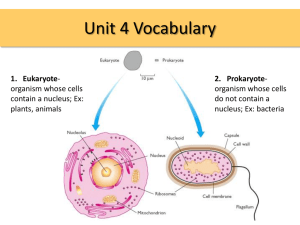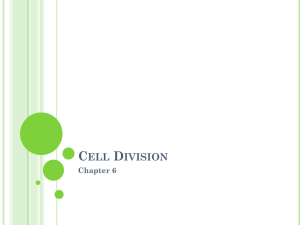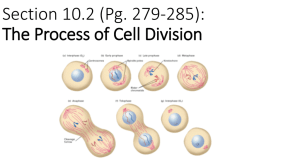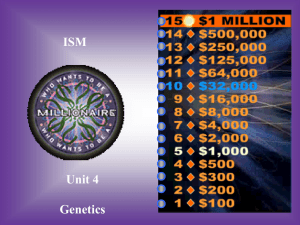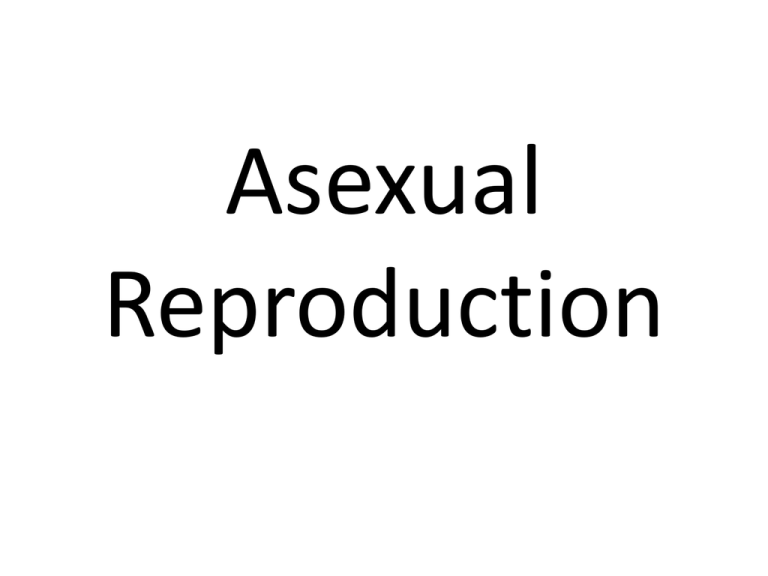
Asexual
Reproduction
• Reproduction not involving the union of
gametes
• Ex: mitosis
• Ex: Budding and Binary fission
Binary Fission
• An asexual cell division of prokaryotes that
produces identical offspring
• Ex, bacteria dividing by mitosis.
A dividing bacterium
A budding Yeast cell
Sexual Reproduction
• Combination of two set of DNA to form
a diploid organism.
•Can be external as in fish, amphibians or
internal as in mammals.
DNA Replication
• An exact DNA copy is made.
• A process called “semiconservative
replication” because the DNA has one old
strand on one new strand.
The process of DNA
Replication
1.
2.
3.
DNA separates at the base pair/hydrogen bond
DNA polymerase attaches the complementary DNA
nucleotides
Two identical strands are made, one new and one is the old.
DNA replication animation
http://www.tracy.k12.ca.us/thsadvbio/OnlineLessons.htm
http://207.207.4.198/pub/flash/24/menu.swf
Mitosis
• A process where chromosomes
replicate and are separated to
separate cells.
• One cell divides into two
identical cells
• Diploid number of
chromosomes
• Phases of mitosis are: prophase,
metaphase, anaphase and
telophase. Two cells result after
cytokinesis or the divison of the
cytoplasm
The Cell Cycle
• When a cell first is
formed to when it
divides ( either by
mitosis or meiosis)
• Stages include:
Interphase
(growth and DNA
replication), Mitosis
and Cytokinesis
Interphase
• Stage of the cell cycle where the cell is:
G1(first growth): growing in cytoplasm
S( Synthesis): DNA replication
G2(second growth): organelles, especially centrioles
replicate.
Prophase
• Phase of mitosis where the nucleus and
nucleolus begin to disintegrate, the DNA
condenses into chromosomes and cenrioles
begin to separate to opposite ends of the cell.
(centrioles)
Metaphase
• Phase of mitosis where the chromosomes (
already replicated and look like “X”) line up
ion the center ( metaphase plate)
Anaphase
• Phase of Mitosis where the sister chromotids
separate ( replicate chromosomes) and move
to opposite ends of the cell. They are moved
by the spindle fibers retracting into the
centriole
Telophase
• Phase of mitosis where the cell begins to pinch into
two ( animal cells form a cleavage furrow and plant
cells begin to form a new cell plate). Two identical
cells are produced. The nucleus and nucleolus
reform.
Animal cell
Plant cell
Cytokinesis is when there are actually two cells
Animal cell Mitosis
compared to
Plant cell mitosis
Animal
Plant
-Centrioles present
- no centrioles
-Centrioles produce spindles
-Cytoskeleton produces spindles
-Cleavage furrow (pinching in) -new cell plate/wall formed
to produce 2 cells
to produce 2 cells
Mitosis animation
http://www.ai.mit.edu/lab/olympics/98/events/MITosis/mitosis-animation.gif
http://web.grcc.edu/biosci/pictdata/mitosis/planmito.htm
(plant)
Diploid
• A cell that contains both chromosomes of a
homologous pair.
• One set of chromosomes from each parent
• Union of an egg (23 chromosomes) and a
sprem (23 chromosomes) results in a zygote
with 46 chromosomes or the diploid number
of chromosomes ( for humans)
Somatic
• Body cells (all except gametes)
• Produced by mitosis
• Have the diploid number of chromosomes or
46 in humans
Ex: Skin, muscle, nerve…
Gamete
• A reproductive cell
• Eggs and sperm cells
• These cells contain the haploid number of
chromosomes ( half the full set)
• In humans this is 23 chromosomes
• These cells are produced by Meiosis of
special somatic cells (eggs by oogonia and sperm by
spermatogonia).
• The Cell Cycle for these
cells ends with
gamete formation.
Haploid
• Having only one chromosome of each
homologous pair
• Gametes are haploid or contain 23
chromosomes
• Haploid cells combine to form diploid cells
as in fertilization ( egg combines with sperm)
Meiosis
• The process of nuclear division that reduces the number of
chromosomes in a cell by half
• In humans, the parent cell of the gametes has 46
chromosomes (diploid number). This cell divides by Meiosis to
produce four halpoid cells with 23 chromosomes.
First Division of Meiosis
• The replicated sets of chromosomes pair up into tetrads, the
tetrads line up on the metaphase plate and are separated.
This division results in two cells with replicate sets of
chromosomes. They still need to separate (the second
division)
Second division of Meiosis
• From the first division where there are two cells with replicate
sets of the haploid number of chromosomes, the two cells
now divide similar to MITOSIS and four cells with one copy of
a haploid set of chromosomes is the result.
Crossing Over
• The exchange of genes by reciprocal segments of
homologous chromosomes during meioses
• This occurs during prophase and metaphase of
meiosis I.
Meiosis animation
http://www.sumanasinc.com/webcontent/animations/content/meiosis.html
Fertilization
• Joining of two gametes to produce a diploid
zygote
egg
sperm
Zygote
• The diploid cell that results from the fusion of
gametes
DNA from sperm
= zygote
DNA from egg
RNA
• A nucleic acid composed of a single strand and
distinguished form DNA by containing ribose
and Uracil
• Can be rRNA (ribosomal), mRNA (messenger)
and tRNA (transfer)
• The function of RNA is to read the code of
DNA and produce a protein.
rRNA
(ribosomal RNA)
• The type of RNA found in a ribosome that is
necessary for the messenger RNA to bind to
the ribosome for protein synthesis
tRNA
(Transfer RNA)
• the RNA that match amino acids to the mRNA
• They are free floating in the cytoplasm
• Contain an anticodon ( complement to the
mRNA codon) that allows it to bind to the
mRNA.
mRNA
(Messenger RNA)
• The type of RNA that carries genetic
information from the nucleus to the ribosome
• DNA is transcribed in the nucleus to mRNA
that leaves the nucleus to be translated on a
ribosome.
DNA A T T A T A T C G C T G
mRNA U A A UA U A G C G A C
Ribosome
• An organelle that functions in the synthesis of
proteins
Transcription
• The process in which RNA is made from DNA
• Ex: DNA TTATGCGCTA makes the
mRNA AAUACGCGAU
Translation
• The process of converting the mRNA into the
amino acid sequence that makes up a protein
• Occurs on the ribosome as the ribosome reads
the mRNA and finds the start codon AUG to
start protein synthesis
Protein Synthesis
• The formation of proteins using information coded
on DNA and carried by RNA
translation
1. DNA separates
2. RNA made from the DNA
3. mRNA moves out of
nucleus to a ribosome
in the cytoplasm
4. Ribosome reads the
mRNA, finds AUG to
start protein synthesis
5. tRNA bring the right
amino acid to the mRNA
6. The amino acids
attach to make a protein
7. The proteins affect the
structure and function
of the cell= traits
Protein synthesis animation
http://www.tracy.k12.ca.us/thsadvbio/animations/Protein.swf
http://learn.genetics.utah.edu/units/basics/transcribe/
Practice protein synthesis
Mutations
• Any change in the genetic message
(DNA and RNA)
• Mutations lead to genetic diversity
• Can be a change in only one base
(addition, deletion, substitution)
• Can be changes in chromosomes
• Can be changes in chromosome
number.
Turner’s Syndrome
•
•
•
•
Genetic disorder caused by a mistake in meiosis.
A female with only one X-chromosome.
Missing the second X
Designated as XO
Down’s Syndrome
• Genetic disorder caused by a mistake in meiosis.
• Three chromosome 21s, called triosomy 21
Karyotype
• A picture of an individual's chromosomes
• Aligned in homologous pairs, by size and
location of the centromere.
Dominant
• An allele that masks the presence of another
allele
Ex. Aa is a heterozygous dominant genotype
Ex. AA is a homozygous dominant genotype
“A” is the dominant allele and “a” is the
recessive allele
Recessive
• An allele that is dominated by the other
ex. aa is recessive
• “A” is the dominant allele and “a” is the
recessive allele
Phenotype
• The external appearance of an organism that
is determined by the individual genotype
Different phenotypes of the shells
Genotype
• The pair of alleles that determine a specific
trait.
• Ex: Aa the allelles are A and a
Offspring
• Product of fertilization
Punnett Square
• A model used to establish the probabilities of
the results of a genetic cross
Homozygous
• Referring to a gene pair in which the two
alleles code for the same trait
• AA or aa are homozygous genotypes
Heterozygous
• Referring to a gene par in which the two
alleles do not code for the same trait
• Ex: Aa is a heterozygous genotype
Monohybrid Cross
• A cross between individual that involves one
pair of contrasting traits
Dihybrid Cross
• A cross between individuals that involves the
pairing of contrasting traits
Sex Linked
• A trait carried on only the x chromosomes
Incomplete Dominance
• The inheritance relationship that occurs when
both alleles influence the phenotype
If this was not an incomplete
Trait, there would have been
3 tall and 1 short
Codominance
• When neither of two alleles of the same gene
totally masks the other, they are both
expressed at the same time.
• More than one dominant allele
Ex: Blood types
AA= type A
BB= type B
OO=Type O recessive
AB = Type AB (both are dominant)
Polygenic
• A trait controlled by multiple genes
Ex: eye color. There is not one gene that
Determines eye color, but several
Multiple alleles
• When more than alleles code for one trait
Ex: Blood types
Alleles are A, B , and o Three alleles
Alleles
• Alternative form of a gene, there are two
Dominant A
Recessive a
Pedigree
• A diagram of the genetic history of an
individual, a family tree
Gene Splicing
• Splicing of two genetic codes
• Taking a piece of DNA and moving it, removing
it, or replacing it.
Electrophoresis
• Using electricity to separate DNA on an agarose gel. DNA can
be visualized a a set of bands that were cut by enzymes.
• DNA is “cut” with enzymes to produce fragments.
• The band run through the getl according to size. Small bands
travel faster than larger ones.
Cloning
• Process of removing DNA from one organism
and putting it into another.
• EX: the gene for insulin is removed from a pig
or human and inserted into E.coli bacteria.
The E. coli then produce the insulin that is
purified , bottled, and distributed to people in
need. The insulin was “cloned”
Biotechnology
• Technology used to manipulate DNA,
proteins,RNA and such.
• EX: cloning, DNA fingerprinting, DNA and
protein sequencing.
Genetic engineering
• A form of applied genetics in which scientists
directly manipulate genes
DNA Fingerprinting
• A pattern of bands made up of specific fragments from a
individual's DNA. The bands are produced by putting
enzymes or “moleculer scissors” in with the DNA. These
enzymes cut the DNA at specific sequences producing smaller
fragments. These fragments can be visulaized by DNA
electrophoresis.
http://www.biotech.iastate.edu/biotech_info_series/bio6.html



